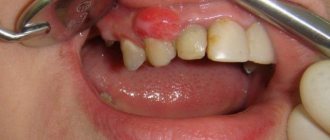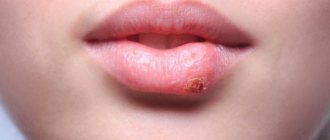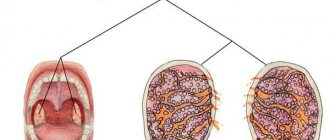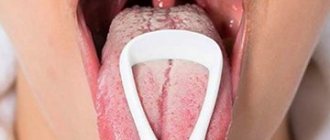September 21, 2020 Last revised: September 13, 2020 Oral diseases
The appearance of a bubble on the inner surface of the lip does not cause concern in most patients. The subsequent increase in size makes one think about the pathological orientation of the harmless neoplasm. A visit to the dentist leads to a diagnosis of “retention cyst on the lip” and the prescription of the necessary treatment.
Types of pathology
To prescribe the most appropriate treatment option, the type of cyst is determined. They are usually divided into four main subtypes, with their own localization and symptomatic manifestations. In some cases, parallel formation of several types of pathological processes may occur.
- Sublingual - localized in the hyoid-maxillary muscle, can affect the submandibular region. With accelerated growth and reaching large sizes, it creates a feeling of discomfort when talking or eating.
- Submandibular - formed in the triangle of the lower submandibular region, felt during palpation as a compacted ball with a smooth surface. A pronounced symptom is a partial or absolute disruption of the functionality of the salivary mechanism.
- Parotid - the rarest type of lesion, causes pain when opening the mouth. The early stages are asymptomatic; the cause is various injuries, leading to inflammatory processes and further closure of the lumen in the ducts of the salivary glands.
- Extravasal - formed against the background of mechanical damage. During diagnosis, the presence of granulation tissue is detected; the body of the salivary gland serves as the outer shell.
For any form of the disease, the only treatment option is surgical excision of the resulting cyst.
Causes
Oral mucous cysts are often the result of trauma or injury to the lips or mouth. Common reasons for this are:
- lip biting;
- inner cheek sucking;
- lip sucking;
- piercing;
- abnormal tooth growth.
A mucocele cyst (mucocele) is usually caused by a blocked salivary gland.
It is unclear what causes a mucosal cyst. Fluid in the finger joints may leak through small holes in the joint. This can cause the skin to swell and create a cyst. These small holes can develop as a result of aging.
General information about pathology
Formations on the lower lip account for about 60% of all those occurring in the oral cavity. Blockage of the lumen of the salivary gland causes a disruption of the natural outflow of secretory fluid, leading to stagnation, which results in the appearance of a vesicle.
The disease has the official term “retention cyst” or “mucocele”. The pathology is not prone to degeneration into oncology and is considered relatively safe. The main danger comes from attempts by patients to remove it themselves - by squeezing or cauterizing.
The initially accumulated fluid extends beyond the cyst; over time, the secretion is collected again, and the bubble increases significantly in size. At the same time, the open wound becomes infected, and inflammatory processes develop, leading to complications.
Danger of the pathological process
Standard discomfort caused by the appearance of a neoplasm that interferes with normal life, its gradual growth, leads to mechanical compression of nearby soft tissues. Dystrophic processes developing against this background are considered irreversible.
The gums and mucous membranes undergo changes, the consequence of which is the exposure of the roots of the front teeth of the lower jaw. Thinning of tooth enamel develops due to oxidative processes in the oral cavity - constant access to oxygen activates them. Increased sensitivity of teeth, their loosening, and further loss are the result of refusal of timely professional help.
A large cyst leads to changes in the bite; in adulthood, its correction will take a long time. This disorder interferes with the chewing of incoming food and leads to the swallowing of whole pieces - over time, problems begin with the functionality of the gastrointestinal tract system.
Attempts to bite through an interfering vesicle, especially in children, can lead to the development of purulent-inflammatory processes, with further development into abscesses and septic pathologies.
Reasons for education
A similar pathology appears in connection with various injuries to which the oral cavity is often exposed: burns, biting, or blows. This leads to the fact that the excretory channel of the saliva of the gland is damaged and the secretion produced by it cannot come out, due to which it begins to accumulate, forming a mucocele inside.
Also, the cause may also be atrophy of the excretory ducts of the mucous membrane, when the functioning of the excretory canal itself is disrupted. And this already leads to the development of a tumor, which compresses the duct, while the accumulating mucus stretches it.
In some cases, the cause of the development of pathology is a hereditary factor, which manifests itself after a traumatic effect on the mucosal tissue has been committed.
Such a mucocele is absolutely painless, but if you try to eliminate it on your own, an inflammatory process may begin.
Or, removing the cyst on the lip yourself will lead to the formation of an ulcer in its place, and the mucus coming out of it will be a source of infection.
The main manifestations of a retention cyst of the lower lip are:
- Developing mucoceles, when they reach a certain size, can interfere with eating, speaking, and even brushing your teeth;
- The formation has a fairly solid structure and can reach several centimeters in size;
- If the anomaly is damaged, it will release liquid contents that are white or yellow in color. In case of vascular injury, it may be red;
- If such a tumor is emptied, after a certain time it will reappear;
- Painful sensations occur exclusively in the case of inflammation of the pathology.
Cyst on the lip and symptomatic manifestations
The main influence on the appearance of a retention cyst is exerted by:
- inflammatory process - formed against the background of trauma;
- congenital malocclusion;
- the use of incorrectly manufactured removable dentures - inappropriate in size, poor quality;
- hereditary predisposition;
- wearing briquettes to straighten teeth;
- burns of the oral mucosa;
- death of the ducts responsible for the removal of saliva - the secretion stagnates, the formation of a compaction begins;
- biting the lower lip;
- previous operations;
- traumatization of the salivary glands - causes the closure of their lumen, as a result of which the secretory fluid remains in the duct, and as saliva flows in, its size increases;
- lip injuries - often occurring in childhood - from falls, blows;
- scratches.
Important: the process can develop at any age.
Externally, the disease looks like a ball formed from soft tissues with transparent contents. During initial development, its size reaches 0.5 cm. If medical care is refused, the formation thickens and acquires a whitish tint.
The neoplasm consists of a single or multiple chambers, the upper and lower surfaces of which are lined with mucous membranes. The body of the cyst has a pink color, no different from adjacent tissues. The appearance of bluish or bluish tints indicates thinning of the capsule and the possibility of an independent breakthrough of the pathology.
The main symptoms appear:
- interference with talking, eating, brushing teeth
- in case of damage, liquid contents of a whitish-yellow color flow out of it (in case of damaged vessels - reddish);
- after emptying, secondary filling occurs;
- pain syndrome accompanies inflammatory processes.
Important: in the absence of inflammation, a cyst on the lip is painless.
The appearance of a small bubble on the lower lip is a signal that you need to visit a dentist.
Reasons for the development of cysts
A cyst cavity with mucosal contents is formed as a result of the destruction of small salivary glands in the oral cavity. Since the lower lip is the most traumatic location, retention cysts occur most often in this place. A cyst on the lip has several causes.
- Mechanical injury to the oral mucosa. Constant biting and hitting teeth can lead to expansion of the cavity of the salivary gland duct due to disruption of innervation. In this case, the produced saliva continues to flow into the canal, but the lack of contraction of smooth muscles due to mechanical damage does not allow the secretion to pass further, and the cavity stretches. The retention cyst does not stop growing, it increases in size until the wall of the formation cannot withstand and opens on its own.
- Inflammation of small salivary ducts. Due to minor trauma, pathogenic microorganisms can penetrate damaged salivary ducts. When bacteria reach a certain number, the body responds with inflammatory factors to the foreign protein. Now the cyst on the lip consists not only of mucous secretion, but is also saturated with lymph due to the accumulation of inflammatory mediators.
- Necrosis of the excretory ducts of the small salivary glands. This can be caused by long-standing injuries to the oral mucosa, unsuccessful minor operations to remove another cyst (recessive cyst), or surgical tooth extraction. Another reason for the development of desolation and scarring can be a hereditary systemic disease from the group of collagenoses (systemic lupus erythematosus, scleroderma, dermatomyositis). In this case, the salivary duct in one place is blocked by scar or connective tissue. Up to the site of sclerosis, retention of the secretion occurs with the formation of a cyst. Saliva continues to be produced, but there is no way out. Then it accumulates and expands the final part of the duct, forming a cavity sac.
Diagnostic measures
During your initial visit to the dentist, the specialist will:
- collecting a general history - the presence of a genetic predisposition (existing diseases in close relatives);
- suspected causes of formation are trauma, burns, lip biting, smoking;
- palpation examination - when you press on the tumor, it disappears, when the pressure is interrupted, it is filled with secretion.
After a preliminary diagnosis has been made, the patient is sent for diagnostics:
- studying the size and structure of the bubble using ultrasound;
- probing of the channels - for the width of the lumen of the salivary gland duct, the presence of stones in it;
- puncture – determination of the type of fluid contained in the cyst;
- sialography - to image the general appearance of the salivary glands, their ducts, determine the degree of development of the tumor, and diagnose the malignant type of tumors.
Important: timely diagnosis will help avoid the development of degenerative processes in the affected area.
Having received the conclusion, the dentist prescribes appropriate treatment.
Therapy methods
If there is such an anomaly on the lip, treatment should not be carried out independently. If more than two weeks have passed since the cyst appeared, the doctor will immediately prescribe an operation to remove it. The fact is that this is the fastest and absolutely painless process, which is carried out under local anesthesia.
So, the doctor’s assistant should turn out the affected lip (in this case, the lower one) and hold it tightly to reduce the bleeding of blood vessels. Next, several incisions are made along the pathology. After this, the formation is not emptied, which is due to the loss of the contours of the formation in this case. And if even a partial mucocele remains, this will lead to the re-development of the pathology.
Important! For prevention, the minor salivary glands are also eliminated to prevent the appearance of a new cyst.
In addition, it is possible to remove pathology of the lower or upper lip with a laser. Moreover, this method is one of the most effective and accurate. This is due to the fact that the procedure is less traumatic and removes mucocele better. However, after any surgical removal, sutures are applied to the operated area, as well as a pressure bandage. If, after the intervention, the formation on the upper or lower lip was not completely removed, it will appear again, which will require elimination of the gland itself with saliva.
Postoperative period
When the operation is completed, patients are advised to treat the affected area every day, using a special antiseptic solution, and also monitor their condition. As patients note, it is difficult on the first day after surgery.
This is explained by the fact that any action, be it talking or eating, causes severe pain, but after a month everything heals completely. It is also worth noting that the duration of the rehabilitation period itself depends entirely on the size of the removed internal pathology. In this case, a certain visual distortion of the lip may be observed, even long after the operation.
Important! It is possible to do without surgery only if the patient consulted a doctor in the first days of the onset of the pathology and was prescribed appropriate therapy.
Treatment with folk remedies
After the operation is performed, a period of healing of the lip begins, which is quite long. Based on the size of the pathology, the recovery process in some cases takes more than six months. In the first days after surgery, it is very difficult for a person due to extremely painful eating, as well as attempts to speak. Due to this, you only have to eat liquid food through a straw. Treatment using folk remedies at this stage can only be done to relieve the existing inflammation. Various plants are used to prepare alternative medicines.
So, you can use a leaf of Kolanchoe, or aloe, which you must first squeeze out and then apply the juice to the affected area. Due to their antiseptic actions, they can eliminate not only viruses, but also bacteria. Using an infusion of chamomile, calendula, or sage, you can get a similar effect. Using lotions made from ficus trees can also help. To do this, just squeeze out 10 g of juice, which needs to be diluted in 70 g of vodka. Next, place all this in a cold place for several days. To apply, the solution is mixed with water and a cotton swab must be soaked in it.
The use of such drugs makes it possible to eliminate the purulent-inflammatory process, if present. Trying to eliminate the disease without surgery will only have a short-term effect, due to the fact that the cavity will be filled with fluid again.
In addition, trusting the autopsy procedure to a traditional healer is also highly discouraged, as this may be complicated by bleeding. And in order to avoid the development of serious consequences, it is worth removing the formation even before it reaches large dimensions. The most effective way of prevention is maintaining oral hygiene, as well as avoiding injury.
Features of the formation and removal of a retention cyst on the lip.
A large number of people encounter cystic formations in various cavities and organs. Thus, women are very often diagnosed with ovarian cysts, so many people know about the essence of this problem. However, such formations can also form in places unusual for the average person, for example, on the lower or upper lip. A special type of cyst is retention, which differs in the specifics of its formation and treatment.
Pathology treatment methods
Consists of surgical intervention. Before carrying out the manipulation, wait several days - some of these formations have a tendency to self-resorb. If this does not happen, then the time for the operation is set.
The surgery is performed in a dental office under local anesthesia. The doctor removes the formation and applies stitches. They are removed on the fifth or sixth day from the moment of manipulation. In case of a secondary relapse of the disease, the salivary gland that has undergone pathology is removed.
If there are violations at the time of the classical operation, it is possible that the body of the cyst will be accidentally punctured and its contents may escape. This complicates surgical manipulation - if the remnants of the cyst are not cleaned sufficiently, its re-formation occurs.
A modern method of surgical intervention is laser therapy. Considered a safer form of treatment, it is performed within half an hour. Complications in the postoperative period are practically not recorded; final recovery occurs within a month. Recurrence of neoplasms is recorded in rare cases.
Drug therapy
Used as an auxiliary direction of general treatment. It is used in the postoperative period to speed up recovery and prevent the development of possible complications.
At home, the patient should disinfect the oral cavity:
- "Amident";
- "Hexicon";
- "Miramistin";
- "Chlorhexidine."
Treatment is carried out after each meal, in the morning and evening hours, in order to suppress the development of inflammatory processes.
Diagnosis and types of treatment
A preliminary diagnosis is made based on clinical manifestations. Standard laboratory tests in this case provide little information. The examination is carried out using ultrasound, x-ray examination using a contrast agent. Puncture of the formation, biochemical and cytological analysis of the taken material are considered mandatory.
Differential diagnosis – exclusion from suspicion of benign (lipoma, dermoid, hemangioma) and malignant tumors. In addition, the clinical signs of cysts are similar to lymphadenitis.
The only effective treatment to completely get rid of the problem is surgery. Depending on the location of the cyst, access is carried out from the oral cavity or externally. Removal of a retention cyst of the minor salivary gland is carried out using the method of “husking” from the mucosa under infiltrative anesthesia. In other cases, it is used: drainage of the gland, its removal, excision of surrounding tissue.
Treatment with folk remedies does not eliminate the formation, but is aimed at preventing the inflammatory process. Among the effective recipes for rinsing:
- a solution of baking soda and salt, in equal proportions;
- 10 ml of eucalyptus oil diluted in a glass of water at room temperature;
- decoction of chamomile, sage or calendula.
Treatment at home
It is carried out as an auxiliary technique in the postoperative period to accelerate the healing of the mucous membranes of the oral cavity. There is no therapy that replaces surgical treatment. Common recipes include:
- The juice is squeezed out of finely chopped aloe (Kalanchoe) leaves. Treat the suture site three times a day. Plant juice has an antiseptic, anti-inflammatory, wound-healing spectrum of effects.
- Take half a tablespoon of chamomile and sage and pour a glass of boiling water. Infuse for half an hour, filter thoroughly. Rinse the mouth with the prepared infusion after each meal.
- Ficus juice (about 10 grams) is mixed with 70 grams of medical alcohol and kept for two days. The tincture is diluted with clean drinking water in a ratio of 1 to 1, a cotton ball is moistened in it, and applied to the affected area up to 3 times during the day.
- Walnut shells (15 pieces) are filled with medical alcohol (half a liter) and infused for a week. A tampon is soaked in the resulting mixture and applied to the surgical site twice a day.
Before using any home treatment, it is necessary to conduct a preliminary test for the occurrence of spontaneous allergic reactions. The finished medication is applied in a small amount to the inside of the elbow. Wait up to 20 minutes; if there is no reaction (itching, redness, rash), then you can begin therapeutic measures.
Important: when conducting the initial test, relatives must be near the sick person to call an ambulance in case of complicated allergies (anaphylactic shock, Quincke's edema).
Treatment
You can get rid of a mucous cyst on the lip using one of the home treatments. However, a medical professional must confirm the correct diagnosis. Care measures should be taken into account to avoid complications such as bacterial or viral infection. Sometimes having persistent injuries can prolong the healing process.
Although mucoceles are not a serious health risk, treatment should be considered to prevent the problem from recurring. A mucous cyst should usually go away on its own, but some cases require a surgical procedure.
Surgical therapy
Surgery is considered the best treatment for any mucous cyst, including on the lip. If there is pain, recurrent infection or chronic drainage, surgery is recommended.
There are several types of surgical procedures to remove a mucous cyst. These include laser technology and minimally invasive methods that are aimed at reducing recovery time and minimal trauma. However, removing a mucocele with surgery or laser does not necessarily mean it won't come back.
Recovery after surgery
The recovery period after removal of a mucous cyst through surgery depends on a number of factors, including the person's general health and/or post-operative oral care.
Mouth movement should be kept to a minimum for at least 48 hours. It is also important not to touch objects or fingers to avoid infection.
Swelling after surgery lasts up to 48 hours. To make it easier, use an ice bag and place it tightly next to the operated area.
You should stop smoking and drinking alcohol for at least two days to ensure the healing process. Also, avoid foods that irritate your lip, such as orange juice or lemon.
Preventive actions
Associated with the implementation of a number of rules:
- to give up smoking;
- exclusion of spicy foods and scalding drinks from the daily diet;
- getting rid of the habit of biting lips, cheeks, tongue;
- timely sanitation of the oral cavity;
- correction of malocclusion;
- selection of suitable dentures;
- adjustment of dental briquettes;
- avoiding trauma and chemical burns to the lips.
Compliance with preventive measures will prevent the development of mucocele and maintain the health of the mucous membranes. If you have an existing illness, it is necessary to consult a specialist, diagnose it, and further treat it. Self-therapy is not acceptable and is fraught with complications.
Types of cystic formations of the salivary glands
A salivary gland cyst is a single- or multi-chamber formation filled with almost clear fluid. In the practice of dentists and facial surgeons, this problem often occurs, since the oral cavity contains a large amount of glandular tissue, in which saliva is formed. Large clusters of such cells form large glands (submandibular, sublingual and parotid), and small clusters form small glands.
Doctor's note: patients at any age are susceptible to the formation of cystic formations - both adults and children; the largest number of cases are diagnosed before the age of 30. They appear with equal probability in both women and men. Thus, neither gender nor age characteristics have any special influence.
Based on the nature of the mechanism of cyst formation, there are several main types:
- ramolization formation, formed during partial necrosis of tissue and accompanied by its softening and liquefaction;
- a parasitic cyst is one of the stages of development of tapeworms that have penetrated the tissue;
- traumatic - a cavity formed as a result of mechanical damage to tissue;
- tumor - the growth of a neoplasm can lead to the formation of chamber cavities;
- and a retention cyst, which is acquired in nature and is formed due to a violation of the outflow of secretions.
Thus, a retention cyst differs significantly from other types of formation in the salivary glands, since its occurrence is based on a difficulty in the outflow of saliva, which has arisen for one reason or another, due to which the secretion accumulates and gradually “swells” the tissue with watery filling.
How is treatment carried out?
Cysts on the lip are treated in several ways:
- Surgical intervention.
- Medicines.
- Folk remedies.
Let's look at each of the methods in more detail.
Operation
To permanently get rid of a growth on the lip, it is necessary to undergo surgery. But doctors do not always resort to this method of therapy. To begin with, they suggest waiting a few days, since there is a possibility that the cyst will be able to resolve on its own.
- The process of removing the cyst is carried out surgically, and the operation is performed by a dentist.
- To do this, the patient is injected with local anesthesia into the lip, and after the operation, stitches are placed.
- After surgery, swelling of the lip may be observed for several days.
- When removing the growth, the doctor must be extremely careful not to harm the thin lining of the cyst. If this happens, then all the liquid in it will leak out and it will be difficult to understand where the growth ends.
- If the cyst was not completely removed, then there is a high probability of relapse. The second time the operation will be performed to remove the salivary gland.
Today, to remove cysts on the lip, doctors use an innovative method of therapy - laser technology. Thanks to this procedure, the risk of complications is minimized. The duration of the procedure is 30 minutes.
The popularity of laser treatment is due to the fact that there is no heavy bleeding or damage to the mucous membrane of the salivary glands. It is these factors that complicate the process and increase the duration of the operation. In addition, during routine surgery, doctors use strong anesthetics. Laser therapy is a gentle method, since it involves the use of less potent anesthetics, and this reduces the risk of complications.
The laser operation is performed under local anesthesia, and then thin sutures are applied; they can dissolve within a week. The contents of the growth must be sent for histological examination; this procedure is mandatory when removing various tumors. Thanks to such diagnostics, it will be possible to understand the nature of the tumor and eliminate complications in time. The duration of the operation is 40 minutes. Complete healing of the wound occurs within a month, and the likelihood of relapse is minimal.
Medicines
It is impossible to cure a cyst on the lip with medications alone. As a rule, they are used after surgery in order to speed up the healing process and prevent the formation of complications.
After the cyst has been removed, the specialist cleans and stitches it. It resolves within a week. The patient should treat the wound with chlorhexidine at home to disinfect it.
After each meal, apply Fucocin ointment. It has a healing effect. The wound will heal completely only after six months. If the affected area was insignificant, then recovery can be expected earlier. During the first few days after surgery, the patient will experience discomfort and difficulty speaking and eating.
Video: the process of removing a retention cyst of the lower lip.
Folk remedies
It is impossible to remove a cyst on the lip using traditional methods. They can be used as prophylaxis or in combination with other methods of therapy. The most effective include:
- saline solution - you need to place a small amount of soda in a glass of warm water. You can get the maximum effect by adding a few drops of iodine. Use a mouth rinse solution. Similar events are held several times a day. The prepared solution has an excellent disinfectant effect and relieves inflammation, preventing further growth of the tumor;
- alcohol tincture with horseradish - grind the horseradish, place the pulp in alcohol and leave for 3 days. Use for rinsing. The solution has an excellent antiseptic effect, removes foreign bacteria;
- decoctions - you can use chamomile for preparation. Calendula, sage, oak bark, yarrow. The herbs presented can be combined or used separately. Prepared decoctions perfectly stop the inflammatory process and disinfect the oral cavity;
- Garlic - Since ancient times, garlic has been considered an excellent antiseptic product. Take a few cloves of garlic, chop and apply the resulting pulp to the affected area of the lip. This product perfectly heals cracks and wounds, makes gums stronger;
- Kalanchoe juice - turn the plant leaf into a paste and apply it to the affected area of the lip. The juice has a healing effect and relieves inflammation;
- ficus tincture - finely chop the leaves of the plant, put them in alcohol and wait 3 days. Dilute the resulting solution with water, moisten a cotton pad and apply to the affected part of the lip.
A lot of people come to me for help in treating lip cysts with folk remedies. Many people are depressed by a transparent, ugly, small-diameter bubble on the lip. It occurs because the patient delayed his visit to the dentist in order to treat stomatitis and take some measures. Sometimes blisters occur due to biting the lip (infection). Sometimes such a cyst on the lip resolves on its own, and sometimes you have to wait several months for this to happen.
A labial cyst is unaesthetic and very unpleasant. But the main thing is that I can help everyone who turns to me for help without surgical intervention. In my opinion, it is better to do without surgical incisions: firstly, they take a long time to heal, secondly, there will be swelling after the operation, and thirdly, a very ugly scar may remain for the rest of your life. It is better to treat lip cysts using traditional methods. I use several good witchcraft recipes in my practice. I'll be happy to share them.
Astrologers have calculated
which zodiac signs will attract good luck this month. Your personal horoscope will show you what will help you attract wealth and prosperity. Find out for free
HERE….!
Traditional treatment of lip cysts with tampons and lotions
I often advise my patients to apply cotton swabs with vegetable oil to the cyst. In most cases, it helps at first if the cyst is small.
In my opinion, every apartment should have medicinal flowerpots. The Kalanchoe plant is very helpful in treating lip cysts using folk remedies. You can pick a few leaves from the flowerpot and chew them (be sure to do it for at least 10 minutes several times a day). For a while, you should not spit it out, but leave the chewed leaves in your mouth so that the juice heals the cyst. Kalanchoe can be replaced with aloe, which also heals wounds well and is healing in the treatment of cysts on the lip using folk remedies.
Ficus may even be very useful. In the same way, pick a few leaves from the flowerpot and squeeze out the juice. 10 g of this ficus juice should then be mixed with 70 ml of vodka. The medicine should be placed in the cold for 2-3 days. Before moistening a cotton swab and placing it on the cyst, first dilute it with a small amount of water (1:3).
Infusion for the treatment of lip cysts using traditional medicine
Walnut infusion is very effective to use. Approximately 15 pcs. Peel the pulp, put their shells in a jar (0.5 l) and fill with vodka. Infuse for a whole week in a dark place, wrapped in something warm. The infusion should be taken in the morning before breakfast, 1 tablespoon.
As you can see, there are good methods for treating lip cysts using traditional methods, thanks to which many of my patients were cured of cysts without the scalpel of a dental surgeon.
Tagged with: training, health, enlightenment, self-development, body
The appearance of a bubble on the inner surface of the lip does not cause concern in most patients. The subsequent increase in size makes one think about the pathological orientation of the harmless neoplasm. A visit to the dentist leads to a diagnosis of “retention cyst on the lip” and the prescription of the necessary treatment.











